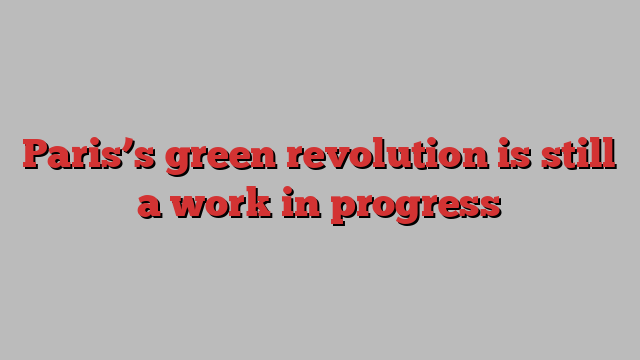
Unlock the Editor’s Digest for free
Roula Khalaf, Editor of the FT, selects her favourite stories in this weekly newsletter.
The writer is the FT’s architecture and design critic
Recently, going through a box of old family photos, I found a black and white snap of my mother sitting on a chair overlooking the Place de la Concorde. It was 1962. The vast square, one of formal Paris’s centrepieces, was a car park.
It’s hard to imagine now but we accept improvements as if they’d always been there and we become a little blasé about the benefits of change. The 19-acre Place de la Concorde is about to become a forest. Or at least that is the rhetoric. The reality is likely to be the greening of its edges and of the Champs-Élysées, which runs from it. But that in itself is no mean feat. Paris’s principal street is now a traffic-clogged, unappealing place trudged by tired tourists. Mayor Anne Hidalgo is using the Olympics to radically realign the city towards a greener future, promising to plant 170,000 trees by 2026 and, by 2030, to have half the city’s area covered by planted spaces becoming, in the process, Europe’s greenest capital.
The green transition hasn’t been entirely smooth. Motorists, a coalition of wealthier and poorer residents from the edges of the city, deride Hidalgo as a “bobo”, or bourgeois bohemian, creating a city for wealthy hipsters. Yet she has ploughed on with plans to remove traffic from streets outside schools, turning them into social spaces for both children and their parents.
A recent referendum led to the tripling of parking charges for SUVs. Parking spaces remain an insanely wasteful use of space, a temporary privatisation of a part of the city for personal use. Meanwhile, though, plans to create a garden around the Eiffel Tower resulted in uproar when the city authorities began cutting down mature plane trees to make it, bizarrely, greener.
Amid all this there is also the issue of the Seine and its “reconquest”. As London’s rivers fill with effluent so rowers get sick, Hidalgo had a swim in the Seine and the river was used for Friday’s Olympic opening ceremony.
On top of this, the city, learning from London, is reusing existing spaces and stadiums, while all new buildings contain wood, including the accommodation for the athlete’s village, which is due to become city-owned social housing.
Trees are everywhere, from the streets and squares to the structure of the impressive new aquatics centre, and building regulations have been changed to allow it to happen. But it is the greening that remains the most visible, dynamic intervention. The vast circular postmodern Place de Catalogne is being transformed with almost 500 trees. And a new neighbourhood, the zero-carbon “ilôt fertile” near Porte d’Aubervilliers, has been conceived around allotments, parks, roof gardens and green terraces.
Paris has historically revelled in a formalised version of nature; avenues of trees, parks set out in geometric lines, small, mostly paved squares with perhaps a few big plane trees. It is a city of about 484,000 trees. In contrast, London has about as many trees as residents, perhaps 8.4mn. Trees enjoy proximity, space in which their roots can commingle and they can create their own small ecosystems and microclimates. Paris, with its zinc roofs and tarmac surfaces, is the perfect example of an urban heat island, a city that struggles to cool down at night.
The strong showing of the far right in recent elections in France is often taken to indicate a backlash against green policies. As in so many cities, the collision in Paris is between the middle classes in the centre and the more car-dependent on the edges. But the French capital is also building a new metro line linking some of the banlieues to the centre and its public transport is good. There is no doubt that swapping cars for trees can make the city a more pleasant place to live and to visit. The question is whether Hidalgo can somehow reconcile the citizens with the saplings to pull off a remarkable transformation.